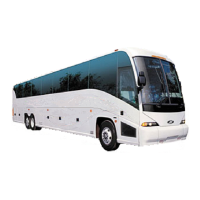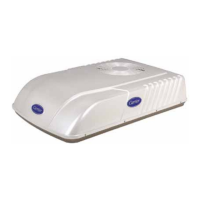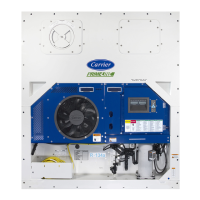3-2T -312
Table 3-3. Driver Display Panel Alarm Message Definition - Continued
ALARM
NO.
TITLE CAUSE REMEDY MICROPROCESSOR RESPONSE
A14 Ambient
Probe Failure
Sensor is unplugged,
wiring defective or
ambient temperature
sensor failure.
Ensure sensor is
plugged in. Check
sensor resistance or
wiring. Replace sen-
sor or repair wiring.
(Refer t o section 4.13
and Table 4-3.)
Ignores ambient temperature and
does not lock out the compressor
and does not open driver RAM air in
AUTO mode.
A15 Suction P ress-
ure
Transducer
Failure
Sensor is unplugged,
wiring defective or
suction pressure trans-
ducer failure.
Ensure sensor is
plugged in. Check
transducer voltage or
wiring. Replace sen-
sor or repair wiring.
(Refer to section 4.15
and Table 4-5.)
Energizes unloaders.
A16 Discharge
Pressure
Transducer
Failure
Sensor is unplugged,
wiring defective or
discharge pressure
transducer failure.
Ensure sensor is
plugged in. Check
transducer voltage or
wiring. Replace sen-
sor or repair wiring.
(Refer to section 4.15
and Table 4-5.)
Energizes unloaders.
A17 Humidity
T ransducer
Failure
Sensor is unplugged,
wiring defective or
humidity transducer
failure.
Ensure sensor is
plugged in. Check
transducer voltage or
wiring. Replace sen-
sor or repair wiring.
(Refer t o section 4.14
and Table 4-4.)
If conditions allow, not including the
humidity set point/humidity sensor
condition, activates humidity control
(dehumidification). (See section
2.3.4.) Does not open passenger
RAM air in AUTO. (Refer to section
2.3.11.)
A18 Fuse Blown
Alarm
Defective wiring or
coach power source de-
fective. microprocessor
Internal fuse is blown.
Repair or replace
wiring or power
source. Replace Fuse.
All microprocessor outputs are de-
energized.
A19 Main
Evaporator
Fan Overload
Main evaporator fan
overload.
Refertosection3.3.6. No microprocessor response other
than alarm.
A22 Condenser
Fan Overload
Condenser fan over-
loads
Refertosection3.3.3
and/or 3.3.4
If the compressor is energized and
the first condenser fan overload
opens, the microprocessor will ener-
gize the second condenser fan i n or-
der to detect the first overload con-
dition.
If, after energizing the second con-
denser fan, the second condenser fan
overload opens, the compressor
clutch will de-energize for the mini-
mum off time, since neither con-
denser fan is operating.

